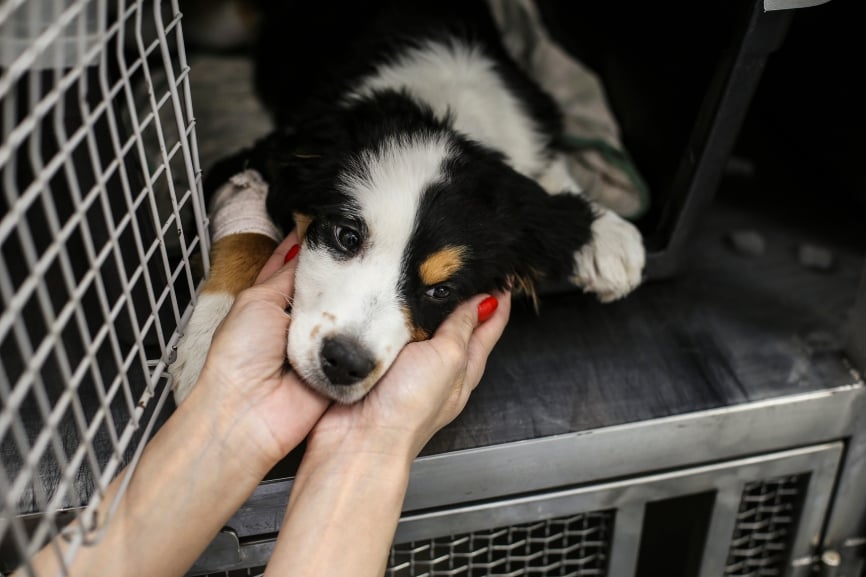Table of Contents
Many of us are familiar with community-driven pet programs like the police department K9 units, service guide dog organizations and non-profits that bring therapy pets to nursing homes and children’s hospitals. What may surprise you to hear is that many prisons have established successful pet programs as well, and some of them are involved with training those very dogs you see working.
While programs vary from prison to prison, one of the primary goals is to rehabilitate and train shelter dogs to improve the pup’s chances of being adopted into a forever home. Then, other programs train service dogs to be used by government agencies, private security firms or in-need owners. All the programs help the dogs (some are pulled from euthanasia lists) and their future humans; however, one of the most heartfelt consequences is that it also helps the prisoners.
How prison pups improve inmate morale
Those of us who have interacted with a dog can attest to their ability to bring us joy, and a study published by Miho Nagasawa at Japan’s Azabu University in 2009 proved that hanging out with a pup can increase levels of oxytocin (often dubbed “the feel-good hormone”). HABRI, the Human-Animal Bond Research Institute, has also concluded in studies that there is a “pet effect” on depression: those who engage regularly with pets show increased confidence, more sense of purpose and an overall better picture of health than ever before.
From there, we can easily see “the pet effect” on incarcerated individuals. A study using subjects from two Kansas prisons assessed the effects of inmates training assistance dogs in correctional facilities. They discovered increased inmate morale and reduced recidivism. “Many of [the prisoners] we interviewed believed that the strongest positive they receive from the program is the change it affects in their attitudes and emotions,” the researchers stated. “For these men, the dogs are truly therapeutic. Participants believe that the dogs help them to deal with anger, teach them patience, give them unconditional love and simply make doing time a little easier.”
The Prison Pet Partnership (PPP), established in 1990, has found the same results. “At PPP, we train service, therapy and companion dogs. Our service dogs are primarily purpose-bred dogs from other service dog programs, but the dogs we rescue can also go on up through the training to become service dogs. The majority of the rescue dogs don’t have the temperament to be service or therapy dogs, but are placed as companion pets or ‘Paroled Pets,’ as we call them,” said PPP’s Executive Director Beth Rivard.
She added, “The inmates say that the dogs really help to keep the stress level down, and that the dogs are a big distraction to the everyday life in prison. Some women have said that by training dogs, this is a way that they can give back to the community that they have taken so much from.”
Rehoming Prison Pups
At the end of their prison training programs, the fully trained prison dogs are either put up for adoption to the general public, or utilized as service dogs.
For example, The New York Times covered the story of a yellow Labrador retriever named Opelika (named after the Alabama city she both lives and is trained in), who was part of the Canine Performance Sciences Program at Auburn University. Each dog in the program undergoes their own year-long training period. Six months of Opelika’s coaching occurred in a state prison, “where inmates who have earned the right to work with the program’s dogs lavish time and attention on them to hone their detection skills and reinforce basic socialization.” Upon completion, Opelika would be “placed with a government agency, or private security firm, to sniff out bombs, narcotics or other threats.”
This, of course, is just one example of thousands. To get more of an inside look at how prison dogs positively impact the lives of inmates, pups and the community, tune into the Prison Dogs documentary. Filmed in New York at the Fishkill State Correctional Facility, it follows the Puppies Behind Bars program, “which teaches a select group of inmates to train puppies to become service dogs for disabled veterans, whether suffering from PTSD or physical injuries that render them immobile,” as well as for law enforcement. Grab the kleenex!
At Healthy Paws Pet Insurance, we believe in the power of pets. Through the Healthy Paws Foundation, we support organizations like HABRI and rescue nonprofits, making huge leaps to show how important pets are to our well-being. And with every free quote for pet insurance, we make a donation towards a homeless pet’s medical care.








